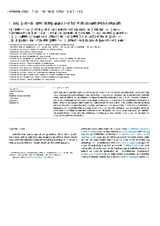A new method for determining the sources of airborne particles
Autor
Oteros, José
García-Mozo, H.
Alcázar, Purificación
Belmonge, Jordina
Bermejo, Daria
Boi, Marzia
Cariñanos, P.
Díaz de la Guardia, C.
Fernández González, Delia
González-Minero, Francisco
Gutiérrez Bustillo, Adela M.
Moreno Grau, Stella
Pérez-Badía, Rosa
Rodríguez-Rajo, F.J.
Ruiz Valenzuela, Luis
Suárez Pérez, Julia
Trigo, M. Mar del
Domínguez Vilches, E.
Galán, Carmen
Editor
SpringerFecha
2015Materia
Airborne particlesPollen
Environmental monitoring
Geostatistic
Dispersion
Environment
METS:
Mostrar el registro METSPREMIS:
Mostrar el registro PREMISMetadatos
Mostrar el registro completo del ítemResumen
Air quality is a major issue for humans owing to the fact that the content of particles in the atmosphere
has multiple implications for life quality, ecosystem dynamics and environment. Scientists are therefore
particularly interested in discovering the origin of airborne particles. A new method has been developed
to model the relationship between the emission surface and the total amount of airborne particles at a
given distance, employing olive pollen and olive groves as examples. A third-degree polynomial relationship
between the air particles at a particular point and the distance from the source was observed,
signifying that the nearest area to a point is not that which is most correlated with its air features. This
work allows the origin of airborne particles to be discovered and could be implemented in different
disciplines related to atmospheric aerosol, thus providing a new approach with which to discover the
dynamics of airborne particles.

